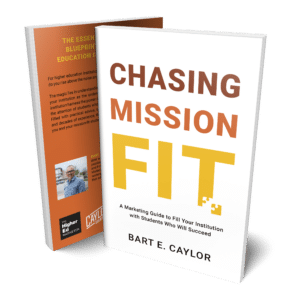How Ivy Tech Built a Multi-Campus Brand Strategy That Works
Learn how Ivy Tech uses a multi-campus brand strategy to align 19 campuses with trust, research, and innovation.
Featured
Building a generative AI playbook may not feel urgent.
But it is increasingly important.
For small college marketing teams working with limited time, budget, and staff, generative AI often feels like both a promise and a puzzle.
You may have heard about its ability to boost efficiency, but the real challenge is knowing how to use AI in a way that supports your mission without overwhelming your people.
That is where a playbook can come in handy.
Instead of jumping from one tool to the next or experimenting without direction, you can establish a framework that aligns AI with your enrollment goals, protects your brand voice, and simplifies daily marketing tasks.
In this article, we will look at why investing the time to create your own AI playbook is worth the effort.
And how it can turn a daunting technology into a dependable partner for your team.
A generative AI playbook is a roadmap your marketing team creates to guide how AI is used within your institution.
It is not a single tool or app, but a framework that defines which tools you will use, how you will use them, and how you will ensure they serve your strategic goals.
With limited staff and resources, it is easy to fall into trial-and-error experimentation or jump from one shiny new AI product to another.
The temptation is understandable, especially when the marketplace is crowded with new AI tools launching almost daily.
It can feel nearly impossible to know which options will truly meet the needs of your institution and which will end up draining more time and budget than they save.
A playbook brings order to the process.
It keeps your team focused on what actually supports enrollment, advancement, and mission-fit marketing.
In short, creating a generative AI playbook helps you get the benefits of AI—efficiency, creativity, and scale, without losing the intentionality and authenticity you need for your team.
A: A generative AI playbook is a framework that helps small college marketing teams decide how to use AI effectively. It outlines goals, selects the right tools, defines workflows, protects brand voice, and trains staff so AI supports enrollment and communication strategies without overwhelming the team.
The first step in creating a generative AI playbook is deciding what you want AI to accomplish for your team.
Without clear goals, it is easy to waste time chasing tools or projects that do not align with your enrollment strategy.
Start by asking:
For example, you might test AI for drafting social media posts, generating blog outlines, or writing first drafts of email campaigns.
![]()
By keeping the project contained, you can learn how AI fits into your workflow without overwhelming your team or risking your reputation.
Small, focused wins also build momentum.
When your staff sees real results—like saved time or better engagement—they become more open to using AI in larger, more complex ways later on.
Once you have clear goals and a small pilot project underway, the next step is selecting the right tools to support your work.
This is where many small colleges can feel overwhelmed.
There are hundreds of generative AI tools available, with more appearing each month. Some promise to do everything, while others focus on narrow tasks like writing, image generation, or automation.
The key is to choose tools that fit both your goals and your team’s capacity.
For example, a writing assistant like ChatGPT, Claude, CoPilot, or Jasper can help draft blog posts and emails.
Canva AI or Descript might support quick visuals and video editing.
Automation platforms like Zapier or ClickUp AI can streamline repetitive tasks such as scheduling, formatting, or data entry.
A: Without a playbook, small teams risk wasting time on trial-and-error or chasing every new AI tool. A playbook gives clarity and consistency by aligning AI with enrollment goals, streamlining content creation, and ensuring messaging stays authentic to the college’s brand.
A tool should fit within your budget, be simple enough for your team to adopt quickly, and flexible enough to grow as your strategy expands.
By carefully selecting tools instead of chasing every new release, your team avoids tool fatigue and builds confidence in the systems you do adopt.
A generative AI playbook helps you make these choices with purpose instead of guesswork.
Selecting the right tools is only the beginning. To truly benefit from AI, your team needs workflows that balance automation with human oversight.
AI can handle repetitive tasks like drafting content, reformatting assets, or summarizing information. But your staff must guide, review, and refine the outputs to ensure they align with your institution’s mission and voice.
Let AI generate a first draft of a blog post, email, or ad copy.
Then assign a team member to review it for accuracy, tone, and alignment with enrollment goals.
Finally, approve and publish the content once it meets your standards.
By standardizing how AI is prompted, you reduce inconsistency and save your team from reinventing the wheel each time they use a tool.
This human-in-the-loop approach protects your brand while still giving your team the efficiency boost AI can provide.
It also helps build trust within your staff, showing that AI is here to support them, not replace them.
Even the most advanced AI tools cannot fully capture the tone, values, and identity that make your institution unique.

That is why your generative AI playbook should include clear brand voice guidelines.
These guidelines should spell out your preferred tone, vocabulary, and style, along with words, phrases, or themes that should be avoided.
When your team uses AI, they can feed these guidelines into prompts or use them as a checklist when reviewing drafts. This step ensures that your marketing remains authentic and aligned with your mission.
Decide who drafts, who reviews, and who gives final approval. This structure may seem formal for a small team, but it helps prevent mistakes and ensures accountability.
By pairing AI with a consistent editorial process, you safeguard the credibility of your institution while still gaining the speed and efficiency AI provides.
Even the best playbook will fail without a team that feels confident using it.
Training is essential. Start by helping staff understand the basics of prompt writing and how to give AI clear instructions.
Workshops and generative AI training can go a long way in making the tools approachable.
(Contact us at Caylor Solutions to schedule a custom AI Masterclass for your institution!)
Admissions counselors might use AI to draft thank-you notes after campus visits.
Advancement officers might use it to generate donor outreach emails. By giving practical, ready-to-use prompts, you extend the benefits of AI across departments.
Reinforce the need to fact-check AI outputs, protect student data, and avoid overreliance on the technology.
By setting these expectations early, you prevent misuse and keep your institution’s reputation safe.
With the right training, your team will see AI not as a threat but as a supportive partner in their daily work.
A: Start small. Define your most important goals, such as improving email engagement or increasing applications. Then pilot AI on one project like drafting social posts or blog outlines. This builds early wins, reduces risk, and shows your team how AI can fit into daily workflows.
The final step in creating a generative AI playbook is building in ways to measure results.
Tracking outcomes is what turns AI from a flashy tool into a trusted part of your strategy.
Start with simple metrics.
For instance, if AI saves each staff member three hours per week, that translates into more than 150 hours per year.
When you multiply that by average hourly rates, the savings can be significant.
These numbers make it easier to demonstrate ROI to campus leadership, showing that AI is not just about novelty but about tangible results.
Measuring effectiveness also keeps your playbook alive. By regularly reviewing what works and what does not, you can adjust your workflows, replace tools if necessary, and continue to improve.
In this way, your generative AI playbook becomes not just a document but a living strategy that grows with your institution.
Creating a generative AI playbook is not about chasing the latest technology. It is about giving your team the structure and confidence they need to use AI wisely.
With a thoughtful plan in place, small colleges can cut through the noise of endless tools and experiments.
You can focus instead on the practices that save time, reduce costs, and support your mission to connect with the right students.
The payoff is clarity and consistency.
Your staff will know which tools to use, how to use them, and how to make sure AI always serves the institution rather than the other way around.
Now is the time to create your generative AI playbook and make AI a trusted partner in your enrollment and marketing strategy.
Custom AI Masterclass from Caylor Solutions
A generative AI playbook is only as strong as the people who use it.
That is why we offer a Custom 6-hour AI Masterclass, designed specifically for small college marketing teams.
By the end of the masterclass, your team will not just understand AI, they will know how to apply it consistently, ethically, and effectively within the framework of your generative AI playbook.
If you are ready to give your staff the clarity and confidence they need to use AI well, contact us today and let’s design a Custom AI Masterclass for your institution.
The essential marketing book every higher education institution needs! If you are a higher education marketing professional seeking a fail-safe plan to make your institution stand out, “Chasing Mission Fit” is your guide.
 Discover how to:
Discover how to:
So you can empower your institution with audience-focused marketing strategies, and attract mission-fit students who will flourish in your unique academic environment.
Ready to transform your institution’s marketing approach?
Order now!
Images via Midjourney
Subscribe to The Higher Ed Marketer podcast today!